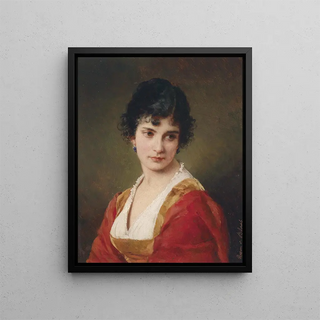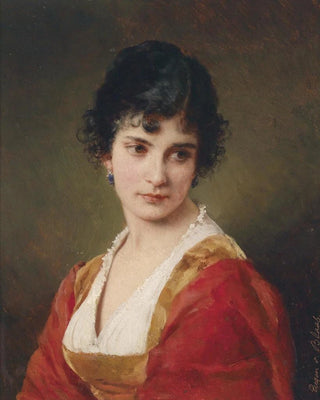Art print | Portrait of a young woman - Eugen von Blaas Source: Reproduction | Portrait d'une jeune femme - Eugen von Blaas


View from behind

Frame (optional)
Portrait of a Young Woman - Eugen von Blaas – Captivating Introduction
In the vast panorama of art history, some works manage to capture the essence of their era while transcending time. The "Portrait of a Young Woman" by Eugen von Blaas is one of those creations that fascinate with their delicacy and intensity. This painting, created at the end of the 19th century, evokes timeless beauty, revealing not only the undeniable talent of the artist but also a poetic vision of femininity. Through this portrait, the viewer is transported into a universe where grace and emotional depth meet, offering a visually intense experience.
Style and uniqueness of the work
Eugen von Blaas's style is distinguished by its meticulous realism and ability to capture moments of life. In "Portrait of a Young Woman," light plays a predominant role, caressing the young woman's face and highlighting the texture of her skin. The details of her clothing, carefully rendered, testify to a keen sense of observation and remarkable technical mastery. The composition, both simple and evocative, allows the work to breathe while focusing attention on the gaze of the protagonist. This gaze, both dreamy and profound, seems to tell a story, an invitation to explore the thoughts and emotions within. The artist thus manages to establish an intimate connection with the viewer, inviting them to reflect on the life of this young woman, her aspirations, and her dreams.
The artist and his influence
Eugen von Blaas, born in 1843 in Venice, is an artist whose career is closely linked to the academic tradition. Trained in the most prestigious art schools, he was able to combine the legacy of old masters with a modern sensibility. His work is marked by a fascination with female beauty, often depicted in historical or mythological contexts. Blaas established himself on the artistic scene of his time, becoming an emblematic figure of the academic movement. His influence is felt among many contemporary artists, who saw in him a model of rigor and passion. Through his portraits, he

Matte finish

View from behind

Frame (optional)
Portrait of a Young Woman - Eugen von Blaas – Captivating Introduction
In the vast panorama of art history, some works manage to capture the essence of their era while transcending time. The "Portrait of a Young Woman" by Eugen von Blaas is one of those creations that fascinate with their delicacy and intensity. This painting, created at the end of the 19th century, evokes timeless beauty, revealing not only the undeniable talent of the artist but also a poetic vision of femininity. Through this portrait, the viewer is transported into a universe where grace and emotional depth meet, offering a visually intense experience.
Style and uniqueness of the work
Eugen von Blaas's style is distinguished by its meticulous realism and ability to capture moments of life. In "Portrait of a Young Woman," light plays a predominant role, caressing the young woman's face and highlighting the texture of her skin. The details of her clothing, carefully rendered, testify to a keen sense of observation and remarkable technical mastery. The composition, both simple and evocative, allows the work to breathe while focusing attention on the gaze of the protagonist. This gaze, both dreamy and profound, seems to tell a story, an invitation to explore the thoughts and emotions within. The artist thus manages to establish an intimate connection with the viewer, inviting them to reflect on the life of this young woman, her aspirations, and her dreams.
The artist and his influence
Eugen von Blaas, born in 1843 in Venice, is an artist whose career is closely linked to the academic tradition. Trained in the most prestigious art schools, he was able to combine the legacy of old masters with a modern sensibility. His work is marked by a fascination with female beauty, often depicted in historical or mythological contexts. Blaas established himself on the artistic scene of his time, becoming an emblematic figure of the academic movement. His influence is felt among many contemporary artists, who saw in him a model of rigor and passion. Through his portraits, he






